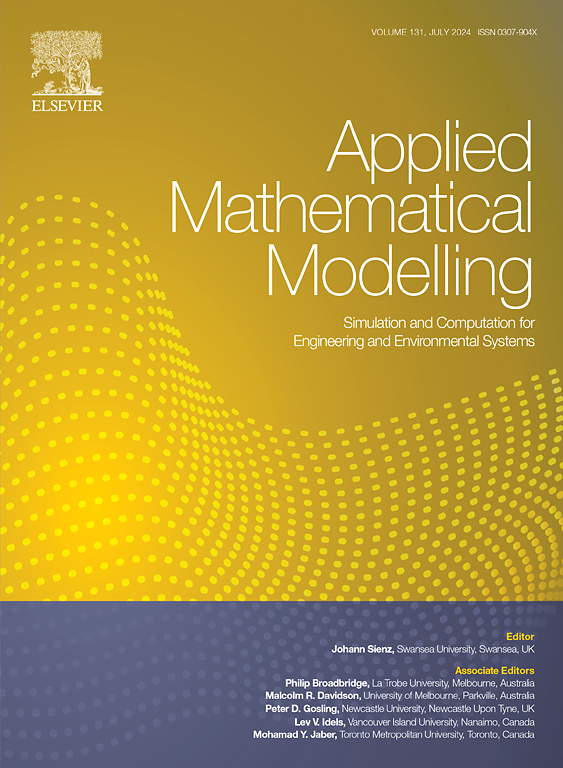物理学知识的神经分数微分方程
IF 4.4
2区 工程技术
Q1 ENGINEERING, MULTIDISCIPLINARY
引用次数: 0
摘要
本研究引入了基于物理的神经分数阶微分方程,这是一种集成了神经ODE、分数阶微积分和基于物理的机器学习的新方法,以推进动力系统的建模。传统方法往往难以捕捉复杂系统的长期依赖关系和记忆效应。基于物理的神经分数阶微分方程通过将Caputo分数阶导数纳入神经网络,将神经微分方程的灵活性与分数微积分和物理定律的力量相结合,解决了这些挑战。这种集成提高了具有复杂行为和非局部效应的系统建模的准确性和效率。我们用预测校正法求解分数阶微分方程,用Adam优化法更新神经网络参数。包括Van der Pol方程、弹簧质量系统和二氧化碳排放模型在内的数值示例表明,基于物理的神经分数阶微分方程在精度和计算效率方面优于传统方法。本研究弥合了分数微积分和深度学习之间的差距,为各种科学和工程领域的复杂动力系统建模和预测提供了强大的工具。本文章由计算机程序翻译,如有差异,请以英文原文为准。
Physics-informed neural fractional differential equations
This study introduces physics-informed neural fractional differential equations, a novel approach that integrates neural ODE, fractional calculus, and physics-informed machine learning to advance the modeling of dynamical systems. Traditional methods often struggle to capture intricate systems' long-range dependencies and memory effects. Physics-informed neural fractional differential equations address these challenges by incorporating the Caputo fractional derivative into neural networks, combining the flexibility of neural ODEs with the power of fractional calculus and physical laws. This integration enhances the accuracy and efficiency of modeling systems with complicated behaviors and nonlocal effects. We use the predictor-corrector method to solve fractional differential equations and the Adam optimization method to update neural network parameters. Numerical examples, including the Van der Pol equation, a spring-mass system, and CO2 emission modeling, show that physics-informed neural fractional differential equations outperform traditional methods in accuracy and computational efficiency. This research bridges the gap between fractional calculus and deep learning, providing a powerful tool for modeling and predicting intricate dynamical systems in various scientific and engineering fields.
求助全文
通过发布文献求助,成功后即可免费获取论文全文。
去求助
来源期刊

Applied Mathematical Modelling
数学-工程:综合
CiteScore
9.80
自引率
8.00%
发文量
508
审稿时长
43 days
期刊介绍:
Applied Mathematical Modelling focuses on research related to the mathematical modelling of engineering and environmental processes, manufacturing, and industrial systems. A significant emerging area of research activity involves multiphysics processes, and contributions in this area are particularly encouraged.
This influential publication covers a wide spectrum of subjects including heat transfer, fluid mechanics, CFD, and transport phenomena; solid mechanics and mechanics of metals; electromagnets and MHD; reliability modelling and system optimization; finite volume, finite element, and boundary element procedures; modelling of inventory, industrial, manufacturing and logistics systems for viable decision making; civil engineering systems and structures; mineral and energy resources; relevant software engineering issues associated with CAD and CAE; and materials and metallurgical engineering.
Applied Mathematical Modelling is primarily interested in papers developing increased insights into real-world problems through novel mathematical modelling, novel applications or a combination of these. Papers employing existing numerical techniques must demonstrate sufficient novelty in the solution of practical problems. Papers on fuzzy logic in decision-making or purely financial mathematics are normally not considered. Research on fractional differential equations, bifurcation, and numerical methods needs to include practical examples. Population dynamics must solve realistic scenarios. Papers in the area of logistics and business modelling should demonstrate meaningful managerial insight. Submissions with no real-world application will not be considered.
 求助内容:
求助内容: 应助结果提醒方式:
应助结果提醒方式:


